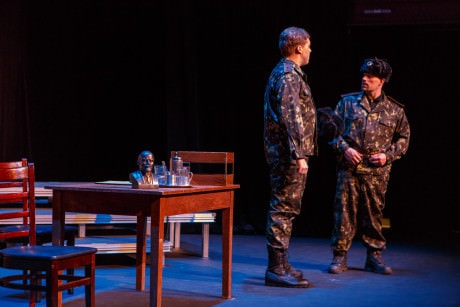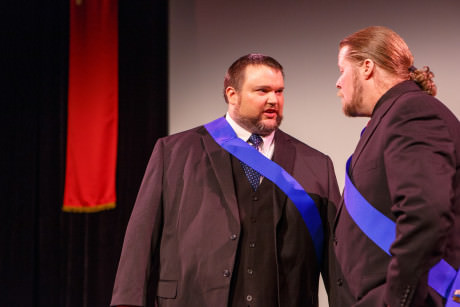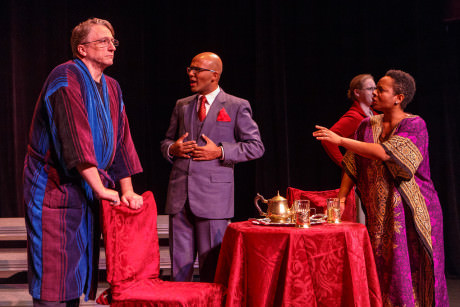It’s 1991, and Julius Caesar, General Secretary of the Communist Party and, for the past year, President of the Soviet Union, is letting his successes and the adulation of the people go to his head. There are rumors that Caesar, who is already dictator, means to be Tsar. He’s denying it for now; three times the people have urged him to accept the crown, and three times he has refused. But everyone knows that’s all a stage show, organized for propaganda purposes — Caesar wants the crown, and sooner rather than later. There has not been, of course, a Tsar in Russia for seventy-four years; not since the revolution of 1917 forced his abdication and put the current regime into place.

The more conservative Soviet hardliners are not taking all this lying down. They are patriotic and dedicated to the survival of the USSR, not only as a nation-state but as a union of social democratic republics. They are faithful communists.They know that the common good depends on stopping Caesar, as do their own privileged interests as top-ranking members of the Party’s oligarchy. They know that they don’t have much time. They’ve lately formed a conspiracy to take Caesar out. It’s led by a cynical, chain-smoking, and very rich Cassius, and by Brutus – Caesar’s friend – a gentle-souled man of unswerving idealism.
This Prince William Little Theater production of Shakespeare’s Julius Caesar, directed by Mary-Anne Sullivan, is rather odd, in a good – if rather confusing – way. The good lies in the picturesqueness and the potential fecundity of the concept. The confusion arises from the fact that little in the production helps one to understand the political situation, or the motivations of the characters, in a coherent way. The autocratizing Caesar is put in the place of the liberalizing Gorbachev; this Gorbachev-Caesar is assassinated by a cabal of reactionary, freedom-loving Communist hard-liners; Antony-Yeltsin remains a dear friend and loyal supporter of Caesar, even though apparently, by 1991, Yeltsin had come to despise Gorbachev, and would undermine the embattled Communist leader at every turn except that year’s hardline coup. To say that it is hard to gather historical insight from this production is an understatement.
I say that defending the concept. The parallels between the fall of the Roman Republic and that of the Soviet Union are imperfect but suggestive, and a certain dramatic energy could arise from the tension created by the congruity and incongruity of pattern between the two historical moments. The experience could be aesthetically, if not intellectually stimulating. Such is not the case here. Instead of creative tension, we find sentimentality. In lieu of historical insight, we get nostalgia-seemingly nostalgia – for a failed totalitarian state.
That being said, this is a very likeable production. It gets off to a rough start, but once it gets going, it becomes really entertaining. By Brutus’ death scene, I was gripped, and I nearly cried when the large-hearted conspirator was eulogized as “the noblest Soviet of them all.” After which a large, vivid hammer and sickle is projected onto the backdrop; this image lingers for a moment, disappears, replaced by a map of the Russian Federation and its satellites. The Soviet Union’s been left broken and destroyed, Brutus and his cohort of faithful Communists aside.
It’s a rather strange experience for an American to suffer pangs of loss at the demise of a longtime Cold War enemy, for a nation that killed tens of millions in the name of ideology and power; one that for decades – in conjunction with the United States, admittedly – threatened the world every day with a nightmare scenario of global nuclear destruction. But it’s a salutary feeling in its way – for we know that many noble men and women lived and died in the Soviet Union, and believed ardently in its cause.

Jay Tilley (Brutus) is one of the most affable actors I have ever seen, one with a large and fun stage presence. He has acted in over eighty productions, and this is his second time playing Brutus, one of his favorite roles. His portrayal of the patriotic patrician is sympathetic and sensitive. This Brutus is kind, emotive, soft-spoken, and gentle. He is a markedly – if subtly – physical actor, one who uses a small gesture or a change of expression to great effect. I do wish that Mr. Tilley would speak his lines with greater modulation – his delivery comes through – aurally – somewhat in monotone I point this out as a piece of helpful criticism, for the problem extends beyond Brutus to nearly all the roles, and I think it’s one that could be fairly easily remedied if the actors were to slow down and feel their lines more. The flat vocal delivery hinders the audience from readily engaging with the characters. Tilley’s a skilled actor and surmounts the obstacle in other ways, not least by sheer charisma.
If Brutus is the most touching character, Matthew Scarborough’s Marc Antony is the funniest. Scarborough’s Antony is large and full of life – a party animal, a loyal friend, an inspiring general. His oration at Caesar’s funeral is the best scene in the play. He moves from subdued, ironic rebukes to outright, frenzied shouting, as the crowd gathered downstage sobs in devastation. The scene as it plays is comic, almost farcical. It’s entertaining, and injects life into a production that has hitherto rather stalled We come back after intermission considerably more alert, and the second half – textually the least dramatic – is here most gripping.
Leland Shook’s Cassius is full of gestural and vocal ticks that at first struck me as distracting affects, then as strong characterizations, then as tiresome repetitions, then as relentless comic assaults. This Cassius is a bastard who makes you laugh, and you are sorry to see him go when he gets dispatched by a dagger in the back.
Scott Olson looks the part of Caesar and cuts a stylish figure. His portrays the aspiring Tsar as an unfazeable public servant. He is a man with an energy as vibrant – and charismatic — as that of a lifelong bureaucrat.
Haliya Robert’s Portia is the image of a concerned, distraught wife. James Masten stands out in two roles – as the rather colorless Casca, and as a rather improbable Octavius Caesar.
If Tilley’s and Scarborough’s are the stand-out performances in major roles, Holly Tupper is the standout among the minor ones, of which she plays several. Poised in posture, she is smart and deft in her movements, and she cries more than convincingly. Along with Scarborough, she delivers her lines in a modulated, engaging voice.

Sullivan has made a number of striking directorial choices that are highly appropriate. A projected film is used to set the mood and bring us – in imagination – to the Soviet era. When the conspirators stab Caesar, she has them don red gloves (bloody hands), which are left on thereafter. Antony comes in – with Caesar dead centerstage, draped in a red Soviet flag – and shakes their hands. My favorite choice is that in the script she substituted Russian for Roman locales, geographic and urban, to better fit the play’s new setting. This keeps us in the Soviet Union with a minimum of cognitive dissonance. The character names are wisely left in Latin.
Besides directing the show, Mary-Anne Sullivan is credited as the producer and costume designer. She collaborated on set design with Lisa Stewart, and on hair and makeup with the actors. Light design is by Lisa Stewart; sound design is by Lynn Lacey; properties and set décor are by Pat Jannell. Besides acting, Leland Shook and Matthew Scarborough contributed to stage combat direction/videography and vocal coaching, respectively. Special effects (projection) are by Rodrigo Pool. Stage Manager and Assistant Stage Manager are Rachel Cherdak and Kaitlyn Renee Elie, respectively.
Overall, PWLT’s Julius Caesar is an ambitious project with a strong directorial vision. It’s enthusiastically executed, charming, different, and I’m sure it’s going to be memorable. I’ve seen more polished shows but rarely one that made me come out smiling – not a snarky smile – but one full of gratitude. Julius Caesar was for me a genuine bright spot in what had been an otherwise dreary day. You vodka go see it.
Julius Caesar plays through October 25, 2015 at Prince William Little Theatre performing at the Gregory Family Theater at the Hylton Performing Arts Center on the George Mason University Campus – 10960 George Mason Circle, in Manassas, VA. For tickets, purchase them online, or at the box office.
LINKS:
Meet The Director and Cast of PWLT’s ‘Julius Caesar’: Part 1: Director Mary-Anne Sullivan.
Meet The Director and Cast of PWLT’s ‘Julius Caesar’: Part 2: Scott Olson, Matthew Scarborough, and Jay Tilley.
Meet The Director and Cast of PWLT’s Julius Caesar: Part 3: Haliya Roberts.





